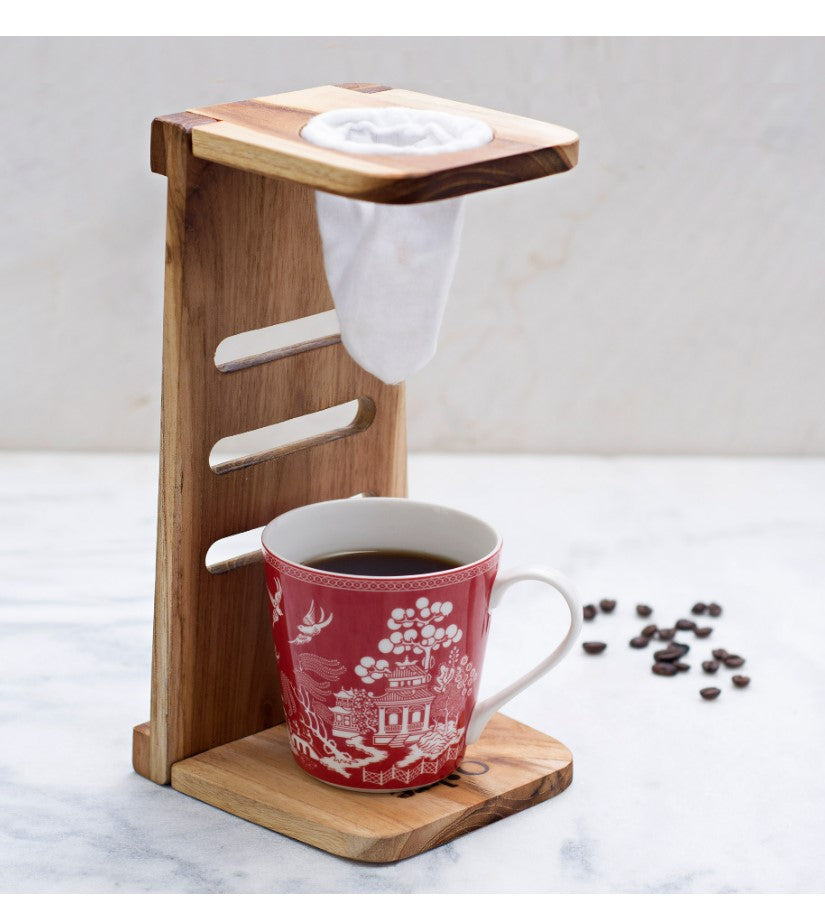
How Chorreador Coffee Reduces Risks and Adds Wellness
Share
If you love coffee like I do, you've probably thought about ways to make it part of a healthy routine without the downsides. I've found that using a Chorreador, that simple Costa Rican setup with a cloth filter, stands out as a smart choice.
It gives you a clean brew that cuts out most of the stuff that can raise cholesterol. I'll walk through the details based on what studies show, focusing on how this method fits into everyday drinking. This is about small changes that add up, not big shifts.
Why Chorreador Coffee Stands Out
A Chorreador uses a cloth bag to filter the coffee, trapping natural oils called cafestol and kahweol that come from the beans. These compounds can increase LDL cholesterol if they make it into your cup, potentially leading to heart problems down the line. The cloth catches a good amount of them, leaving you with a drink that's easier on your system.
Methods without filters, like French press or straight boiled coffee, let these oils through, which some research links to higher cholesterol and even shorter lifespans in heavy drinkers. Switching to a filtered approach like the Chorreador can lower LDL by around 0.58 mmol/L, based on one study of workplace brews. That might reduce heart disease risk by 13% in five years or 36% over 40. If you have a few cups daily, that's worth noting.
Espresso or French press can have diterpene levels 30 times higher than filtered options. Espresso shots vary by machine, with some hitting high marks like 2,446 mg/L for cafestol, making them tougher on cholesterol than a Chorreador pour. Unfiltered boiled coffee leads with about 939 mg/L cafestol.
Cafestol and kahweol do have upsides, like reducing inflammation or helping with blood sugar. For many, though, the cholesterol effect matters more, especially with heart concerns. A Chorreador strikes a balance—it filters enough to limit risks while keeping the full flavor from the cloth's slight permeability.
Here's a table comparing brewing methods by average diterpene levels (cafestol and kahweol combined, in mg/L):
| Brewing Method | Average Diterpene Level | Cholesterol Impact | Notes |
|---|---|---|---|
| Paper-Filtered Drip | 20 mg/L | Low | Traps most oils |
| Chorreador (Cloth) | 28-49 mg/L | Low | Reusable, adds body to taste |
| Filtered Boiled | 49 mg/L | Low to Moderate | Fabric helps reduce oils |
| French Press | 156 mg/L | Moderate | Oils remain in brew |
| Workplace Machine | 317 mg/L | Moderate to High | Metal lets some through |
| Percolator | 160 mg/L | Moderate | Like French press |
| Unfiltered Boiled | 1,617 mg/L | High | Skip for regular use |
| Espresso | Variable (70-3,067 mg/L) | High | Machine-dependent; limit |
This shows the Chorreador holds its own, with levels close to paper filters, meaning less impact on your arteries.
Coffee's Overall Health Advantages
Filtered coffee from a Chorreador brings more than just cholesterol control. Drinking 2 to 5 cups a day connects to lower chances of type 2 diabetes, heart issues, some cancers, Parkinson's, and low mood. Antioxidants in the beans guard cells, ease swelling, and support longer life.
For diabetes, regular drinkers see up to 30% less risk from compounds that aid insulin use. On the heart side, the Chorreador avoids heavy oil loads while improving blood flow. A big review notes 3 to 5 cups cut ongoing disease risks without heart drawbacks.
Coffee doesn't lead to cancer and may block types like liver or endometrial. It also guards brain cells tied to dopamine, lowering Parkinson's odds.
Newer findings link coffee to stronger aging. In a 30-year look at nearly 50,000 women, those drinking caffeinated coffee in midlife faced less frailty, such as weakness or slow movement. Each cup raised healthy aging chances by about 5%. Decaf and tea didn't match, suggesting coffee's special mix.
Caffeine can bring shakes or disrupt sleep if you go too far. Stick to 400 mg a day—roughly 4 cups—for adults. For pregnancy, keep under 200 mg to sidestep birth weight concerns.
Daily Amount and Additions
Go for 3 to 4 cups of Chorreador-brewed coffee each day to get the gains without overload. It delivers antioxidants steadily without leaving you on edge.
Drink it black to skip calories and sugars that can jolt blood sugar or add fats. A bit of low-fat milk is okay if plain. Try cinnamon for taste—it may steady blood sugar. Small honey works, but avoid cream or syrups; they shift coffee toward a treat and dim its edge.
Adding psyllium husk fiber can boost fullness and blood sugar control, useful for targeted tweaks. Mostly, though, keep additions light to highlight the beans.
Brewing Coffee with a Chorreador
A Chorreador is straightforward—a wooden frame holds a cloth sock for grounds. No fancy tools needed. Use 1-2 tablespoons medium-ground beans per 6 ounces water. Heat water to just off boil, wet the cloth, add grounds, and pour slowly in circles for even pull.
Pick Arabica beans for smooth taste over Robusta's bite, and medium roast for acid balance. Grind fresh to hold antioxidants. Store in airtight spot from light and heat—use grounds soon, beans in two weeks.
At work, a portable Chorreador fits easy, or suggest one for the group. It's low-cost, eco-friendly since the cloth rinses and reuses, cutting paper waste. Over time, it builds heart and energy support.
The cloth gives a richer mouthfeel than paper, with subtle oils for depth, but still filters enough for health. Rinse the sock after each use, boil weekly to clean. Start with coarse grounds to avoid clogs, adjust for strength.
In Costa Rica, where it started, people pair it with fresh beans for pure taste. It slows you down, turning brewing into a ritual that fits busy days. If unfiltered methods suit you now, try a Chorreador for a week—the clarity and feel might surprise.
